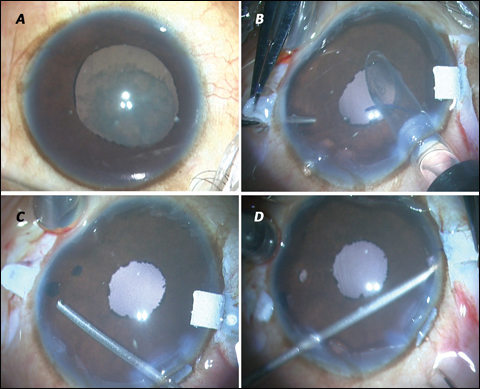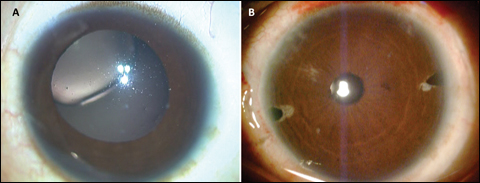Peripheral iridectomy helps prevent iris-related complications in glued IOL procedure
The maneuver is useful in eyes with a greater white-to-white diameter.
Glued intrascleral fixation of an IOL is an established procedure for IOL fixation in eyes with a deficient posterior capsule. The additional advantage with a glued IOL is the absence of pseudophakodonesis as detected on a high frame-per-second recording, which automatically translates into better postoperative visual outcomes.
The shortcoming of this technique is the absence of specially designed IOLs that can be implanted in eyes with a greater white-to-white diameter. In such a scenario, anterior sclerotomy is often performed, which shifts the plane of the IOL anteriorly, allowing more haptic externalization. During this endeavor, the peripheral iris often gets entrapped into the needle that is employed for sclerotomy, resulting in iridodialysis, hyphema, and occasionally an iris tear or an accidental creation of a sclerotomy channel that is anterior to the iris plane. To avert this complication, peripheral iridectomy is performed in eyes with a greater white-to-white diameter that undergo a glued IOL procedure.
Procedure
After making two partial-thickness scleral flaps 180° opposite to each other, a side-port incision is made. Limited vitrectomy is performed in the anterior chamber to cut down all vitreous strands. The cutting rate of the vitrector is brought down to 20 cuts per minute, and low vacuum is set. The vitrector is then placed near the peripheral iris exactly below the 180° axis corneal mark at the proposed site of anterior sclerotomy. The vitrector is then turned upside down, and iridectomy is performed at the most peripheral site below the corneal mark. Following this, anterior sclerotomy is performed at a distance of 0.5 mm to 1 mm from the limbus with the needle directed vertically down toward the mid-vitreous cavity. The glued IOL procedure is performed, and the IOL is fixed and secured in position.

Images: Agarwal A, Narang P


Discussion
Vitrector-assisted peripheral iridectomy allows appropriate and adequate access to the peripheral iris tissue, which can be cut in a controlled manner. Decreasing the cuts per minute of the vitrector allows adequate time for the iris tissue to get engaged in the mouth of the vitrector. Instead, if a surgeon performs peripheral iridectomy at a high rate of cuts per minute, then there is a chance of extra engagement of the iris tissue into the vitrector, which can eventually lead to a big peripheral iridectomy or a complete sectoral iridectomy.
Performing a peripheral iridectomy also facilitates smooth entry and exit of glued IOL forceps from the sclerotomy site and allows haptic externalization without any hindrance. To conclude, performing a peripheral iridectomy helps to avert iris-related complications in a glued IOL procedure.
- For more information:
- Amar Agarwal, MS, FRCS, FRCOphth, is director of Dr. Agarwal’s Eye Hospital and Eye Research Centre. Agarwal is the author of several books published by SLACK Incorporated, publisher of Ocular Surgery News, including Phaco Nightmares: Conquering Cataract Catastrophes, Bimanual Phaco: Mastering the Phakonit/MICS Technique, Dry Eye: A Practical Guide to Ocular Surface Disorders and Stem Cell Surgery and Presbyopia: A Surgical Textbook. He can be reached at 19 Cathedral Road, Chennai 600 086, India; email: dragarwal@vsnl.com; website: www.dragarwal.com.
- Priya Narang, MS, is the director of Narang Eye Care & Laser Centre, Ahmedabad, India. She can be reached at email: narangpriya19@gmail.com.
Disclosures: The authors report no relevant financial disclosures.
